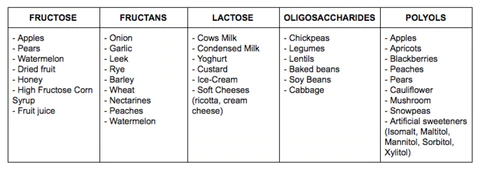The term FODMAP is an acronym that stands for Fermentable Oligosaccharides, Disaccharides, Monosaccharides and Polyols. These are short-chain carbohydrates (sugars) that are not absorbed properly in the gut and can consequently trigger symptoms in people with Irritable Bowel Syndrome (IBS).
When these sugars are poorly absorbed in the small intestine increased water can be drawn into the gut. This can result in diarrhea in some people, whilst for others, the sugars travel to the large intestine where they are fermented by bacteria, producing gases. These gases can cause symptoms such as bloating, constipation, flatulence, pain, and nausea.
FODMAPs are found naturally in a wide range of foods and food additives. They consist of Fructose (in honey, fruits, and vegetables), Fructans (in vegetables and some grains), Lactose (dairy), Galacto Oligosaccharides (legumes and beans) and Polyols (in fruits and artificial sweeteners). A more extensive list of high FODMAP foods can be found below. Please note this list is not complete and is subject to change as new emerging data becomes available.

Table of Contents
What is a low FODMAP diet and what does it involve?
A low FODMAP diet is one that is low in the above compounds. This diet serves to heal your gut whilst reducing symptoms and improving the overall quality of life. It’s important to note that following a strict low FODMAP diet long term has been shown to reduce the levels of beneficial bacteria in the gut, for this reason, it is not recommended that a low FODMAP diet is implemented for a duration longer than 6 weeks.
1. Low FODMAP
This phase involves the strict restriction of ‘high’ FODMAP foods for a duration of 2-6 weeks. Substitutions are made with ‘low’ FODMAP foods whilst your symptom response is noted.
2. Reintroduction
This stage involves reintroducing foods back into your diet in a methodical process to determine which particular FODMAPs trigger symptoms and which do not. During this phase, each FODMAP group is reintroduced separately whilst your background diet remains low in FODMAPs. This is usually completed over a duration of 8-12 weeks.
3. Personalisation
This final stage involves establishing a long term diet, one that is sustainable and nutritionally adequate. After the initial restrictive phase, individuals are able to return to their usual eating habits, with just a few high FODMAP foods that need to be avoided in large amounts. Unlike other conditions that have a particular cause and intern a particular resolution, Irritable Bowel Syndrome affects each individual differently. There is no “one size fits all” therefore individualised and personalised treatment is required.

Is a low FODMAP diet for me?
It’s important to be mindful that not everyone is sensitive to FODMAPS, therefore incorporating a low FODMAP diet unnecessarily can result in nutritional inadequacy if not well supplemented for or if not implemented under the guidance of a medical professional. In saying this, it is essential to consult with an accredited Dietitian before commencing a low FODMAP diet. Furthermore, if you do suspect you may suffer from Irritable Bowel Syndrome or any other bowel issues it is always best to consult your GP first.
By Annalise Farah, Accredited Practicing Dietitian (APD) – BMedSc & MND

